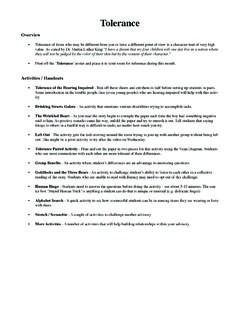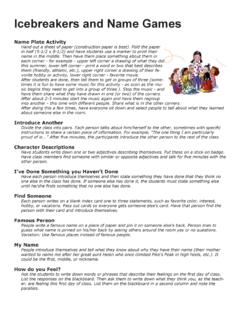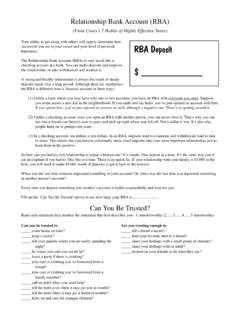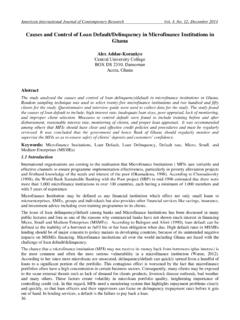Transcription of Icebreakers - Minnesota Middle School Association …
1 Icebreakers ! Select any of the following as activities for your advisory to help them get to know each other. Snowball Fight This activity works with all ages -- including adults. Students write on a piece of paper three things about them-selves. Then they crumple the paper up into a snowball and have a one-minute snowball fight. At the end of the minute, everyone grabs the closest snowball and has to try to find the person who wrote it. They then introduce that person to the rest of the group, sharing the three facts. Non-Musical Chairs Set up chairs in a circle with one less chair than the number of participants. The advisor can start the game by being the person in the Middle without a chair. Each person in the circle starts by introducing themselves to their two circle neighbors on either side.
2 The advisor then introduces themselves to a member of the circle and asks that person who his or her neighbors are. After the student responds, the advisor invites the student to ask a yes or no question of the whole group. That question must relate something true about the student. For example, a student who surfs might ask the group if anyone has ever been surfing. Members of the class who have surfed respond yes not by talking but by getting out of their seats and finding a new seat at least two chairs away. Then the cycle starts again. Students introduce themselves to their neighbors, the person left standing introduces himself or herself to a new person, and the game continues. Match Game Line up your students in two lines facing each other. If you have an odd number of students, then the advisor can play with the unmatched student.
3 Give the students exactly 30 seconds to look at the person with whom they re paired and to study everything about that person. Then the students in one line turn around and close their eyes while the students in the other line change something about themselves. For example, one person may take off an earring, switch shoes, or put their hair behind an ear. Then the kids in the other line turn around and try to name what has changed. Switch roles and play the game again. Alliteration Activity Students form a circle then introduce themselves with their names and something that they like that starts with the same letter as their names. The person who starts the game states the alliteration; then it s the next person s turn. That person repeats what the first person said, then adds his or her name and alliteration and so forth around the circle.
4 For example, My name is Gloria and I love green grapes! The next person in the circle says, Her name is Gloria and she loves green grapes. I am Susan and I love silly stories. Candy Gets Kids Talking! Bring in Skittles or M & Ms. Tell the kids to take as many as they want. Most are pretty apprehensive -- after all, it s the first day of School ! -- so they usually take about 10-15 Skittles. Then the teacher takes some too. Next, pick out some fun music, and for each Skittle they took the students must say one thing about themselves while moving to the music. The teacher demonstrates first, of course. An option: Each color of candy represents a category students must speak about, , orange = scary memories; red = great vacations; green = something about your family; blue = favorite hobbies.
5 A Tangled Web Gather students in a circle sitting on the floor. Hold a large ball of yarn. Start by telling the students something about yourself. Then roll the ball of yarn to a student without letting go of the end of the yarn. The student who gets the ball of yarn tells his or her name and something good about himself or herself. Then the student rolls the yarn to somebody else, holding on to the strand of yarn. Soon students have created a giant web. After everyone has spoken, you and all the students stand up, continuing to hold the yarn. Start a discussion of how this activity relates to the idea of teamwork (for example, the students need to work together and not let others down). To drive home your point about teamwork, have one student drop his or her strand of yarn; that will demonstrate to students how the web weakens if the class isn t working together.
6 Classmate Scavenger Hunt Provide each student with two index cards. Ask each student to write a brief description of his or her physical characteristics on one index card and his or her name on the other. (Physical characteristics usually do not include clothing, but if you teach the primary grades, you might allow students to include clothing in their descriptions.) Put all the physical characteristic index cards in a shoe box, mix them up, and distribute one card to each student (mak-ing sure that no student gets his or her own card). Give students ten minutes to search for the person who fits the description on the card they hold. (There is no talking during this activity, but students can walk around the room.) At the end of the activity, tell students to write on the card the name of the student who best matches the description.
7 Then have students share their results. How many students guessed correctly? Toothpick and Lifesaver Relay Race Teams are formed into lines. Each member gets a toothpick. The first in line starts by passing a Lifesaver to the next person and they pass it on down the line. Players must use only one hand. If the Lifesaver is dropped, the team must start over from the beginning. Cracker Relay Race Set up a chair in front of each team. Place a package of crackers near by. Each person runs out to the chair, takes a cracker, sits down and eats it. As soon as they can whistle, they can run back and tag the next person in line. A varia-tion is to use bubble gum instead of crackers. The students must chew the gum and blow a bubble before tagging the next person. Mime Down the Alley This activity gives students an opportunity to communicate an object or idea to each other so that the last person has the same message as the first.
8 Participants are divided into groups of eight to ten people. Each group sits in a straight line, facing backward except for the first person. Participants are not allowed to talk at any point in the game. The first person in each line is given an object to mime ( , a toaster, a computer, a jack-in-the-box) the only requirement is that it can be shown in pantomime in a seated position. The first person taps the second person in line on the shoulder so that they turn to face each other. The first person mimes the object, and when the second person thinks he knows what the object is, he nods. Then the object is mimed to the next person, traveling down the line to the last person. The objective is for the pantomime of the object to be clear enough each time that it stays the same object all the way down the line.
9 Usually, the object changes into something entirely different the interesting thing is to see how it changed along the line. Each person should tell the others what they thought the object was, and discuss what they saw the others demonstrating. Notes: There are many variations that can be played with this game, by changing the object to a movie or book title, or incorporating concepts from a curricular area into the game. For example, the pantomime could be of a preposi-tion or a science concept. Name Game A game for the first day of class, so that everyone learns each others names. The participants sit or stand in a circle. The leader says, We are having a party, and everyone has to bring something for the party that begins with the same first letter as their name.
10 My name is JANINE, and I am bringing a bag of JELLYBEANS. The person to the leader s right says his name and item, and then repeats the leader s name and item: My name is ERIK, I am going to bring EGG SALAD. This is JANINE, who is bringing JELLYBEANS. Each person in turn introduces himself, announces their item, and repeats the name and item of everyone who preceded them. This means that the last person has to remember everyone in the group, or at least try. The leader should encourage others to help out when participants get stuck on someone s name or item, with verbal or pantomimed clues. I Never Materials (optional): 10 or so tokens for each student A student begins by stating something they have never done, for example I have never visited California. Each student who has done that thing acknowledges it to the person who made the statement by giving a token to the person or by standing up.











